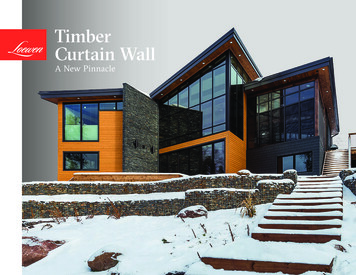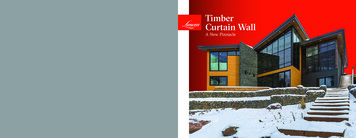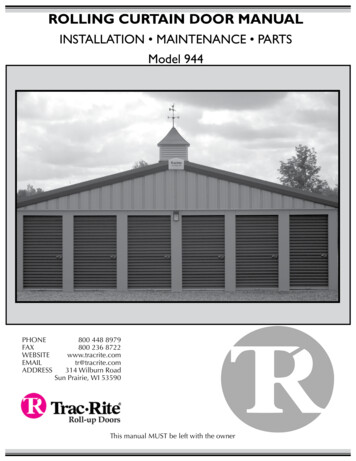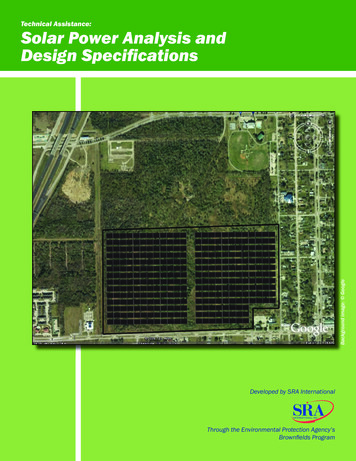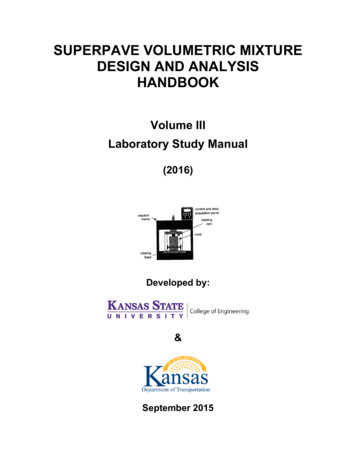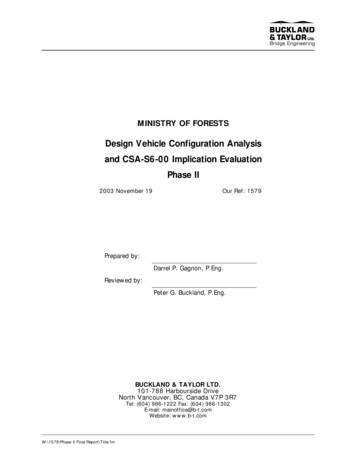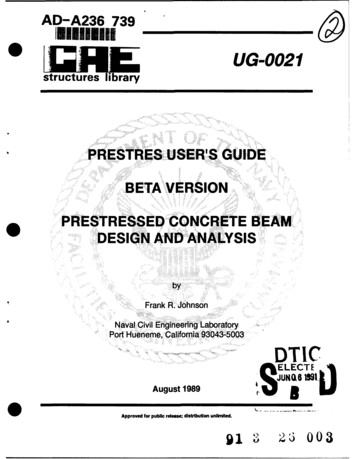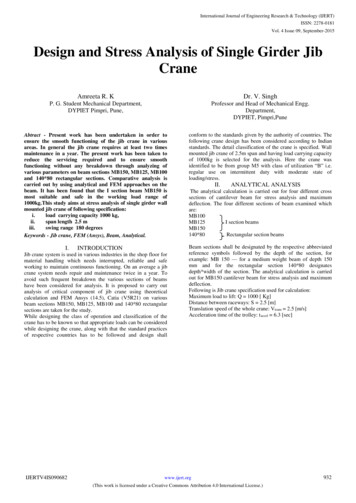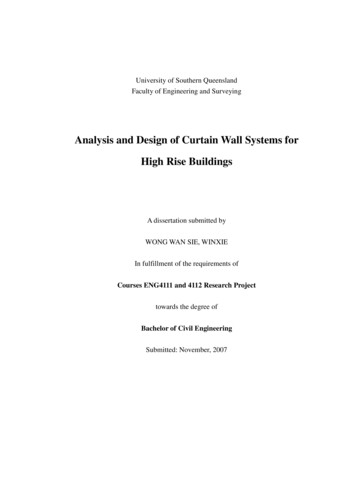
Transcription
University of Southern QueenslandFaculty of Engineering and SurveyingAnalysis and Design of Curtain Wall Systems forHigh Rise BuildingsA dissertation submitted byWONG WAN SIE, WINXIEIn fulfillment of the requirements ofCourses ENG4111 and 4112 Research Projecttowards the degree ofBachelor of Civil EngineeringSubmitted: November, 2007
ABSTRACTFaçades are the first aesthetical feature of a building that distinguish one buildingfrom another. Its distinctive appearance is often the subject of controversial debate.Nowadays, Unitized Curtain Wall system is commonly used for new high-risebuildings, it becomes a major investment in both construction and long-termsuccess of the building. Compared to reinforced concrete structure, unitizedcurtain wall is new technology in the construction industry. This dissertation willfocus on the design and analysis of unitized curtain wall for high-rise building,using finite element and structural analysis programme. The curtain wall systemsnowadays, even the simpler types, are far more sophisticate products than theirearly counterparts, though many of the earliest walls are still performingadmirably. More than fifty years of experience and development have eliminatedthe major difficulties of the pioneering designs, resulting in better products.Beginning with the relatively simple, but innovative concept of the early 1950’s, aseries of window units and panels jointed and supported by simple framingmembers. Curtain wall system technology has developed, over the years, into aproliferation of highly engineered design.The author worked in construction industry for 5 years and working in FaçadeConsultancy for almost 2 years. I am currently engaging in various key Façadeprojects in Asia. I have found that some people simply think that curtain wallsystem is just an assembly of glass, aluminium, steel, screw and sealant. Curtianwall system, apart from its appearance, functions as an external enclosure toprotect the building from weather and to achieve pressure-equalization betweenthe outdoor and indoor environment. Its construction is not only an assembly ofseveral components, but an advanced technology with involves sophisticatedcalculation. In this paper, design concerns of the unitized curtain wall system arealso regarded as major issue to discuss.i
University of Southern QueenslandFaculty of Engineering and SurveyingENG4111 & 4112 Research ProjectLimitation of UseThe Council of the University of Southern Queensland, its Faculty of Engineeringand Surveying, and the staff of the University of Southern Queensland, do notaccept any responsibility for the truth, accuracy or completeness of materialcontained within or associated with this dissertation.Persons using all or any part of this material do so at their own risk, and not at therisk of the Council of the University of Southern Queensland, its Faculty ofEngineering and Surveying or the staff of the University of Southern Queensland.This dissertation reports an educational exercise and has no purpose or validitybeyond this exercise. The sole purpose of the course pair entitled “ResearchProject” is to contribute to the overall education within the student’s chosendegree program. This document, the associated hardware, software, drawings, andother material set out in the associated appendices should not be used for anyother purpose; if they are so used, it is entirely at the risk of the user.Prof Frank BullenDean ofFaculty of Engineering and Surveyingii
CERTIFICATIONI certify that the ideas, designs and experimental work, results, analysis andconclusions set out in this dissertation are entirely my own efforts, except whereotherwise indicated and acknowledged.I further certify that the work is original and has not been previously submitted forassessment in any other course or institution, except where specifically stated.WONG WAN SIE, WINXIEStudent Number: 0050031397SignatureDateiii
ACKNOWLEDGEMENTSI would like to express my sincere gratitude to my supervisor, Dr Stephen Liangfor his endless help and guidance in making this project successful;And, my appreciation is also extended to my current experienced colleagues Mr.Ray Chong, Mr. Matthew Kong and Ms. April Soh who directly or indirectlycontributed to the success of this dissertation.The author also wishes to thank her family for their kind assistance and supportthroughout the course of this project.Miss Winxie WongNovember, 2007iv
TABLE OF CONTENTSCHAPTER 1INTRODUCTION1.1Background information on the research project . 11.2Aims . 71.31.4Structure of Dissertation . 7Summary . 8CHAPTER 2LITERATURE REVIEW2.1Introduction . 92.2Theoretical Studies. 102.2.1Finite Element Analysis Studies. 102.2.2Structural Analysis Studies.112.3Design Codes . 132.3.1ASTM E1300-2004 : Standard Practice for Determining LoadResistance of Glass in Buildings. 132.3.2BS 8118-1:1991: Structural Use of Aluminium. Code ofPractice for Design. 142.3.3BS 5950-1:2000: Structural Use of Steelwork in Building.Code of Practice for Design. Rolled and Welded Section. 152.4Summary . 15CHAPTER 3HISTORY OF DEVELOPMENT OF CURTAIN WALL SYSTEM3.1History of curtain wall system development. 173.2Advantages of unitized curtain wall system compare with stick andsemi-unitized curtain wall systems . 203.3Modern curtain wall system – Unitized curtain wall system . 253.43.5Design of curtain wall system . 26Analysis of curtain wall system . 27CHAPTER 4DESIGN OF CURTAIN WALL SYSTEM4.1Introduction . 284.2Natural forces and their effects on curtain wall system . 29v
4.2.14.2.24.2.3Sunlight . 29Temperature. 30Water . 304.2.4Wind . 314.2.5Gravity. 324.3Design Consideration . 324.3.1Structural integrity . 334.3.24.3.34.3.44.3.5Provision for movement. 35Weather tightness . 37Moisture control . 42Thermal insulation . 434.3.6Sound transmission . 444.4Glass and glazing . 444.5Conclusion . 49CHAPTER 5ANALYSIS OF UNITIZED CURTAIN WALL SYSTEM5.1Introduction . 505.2Case study . 505.2.1Wind Pressure Calculation:. 535.2.2Glass design . 545.2.3Structural modeling . 64CHAPTER 6CONCULSIONS6.1Summary . 916.2Achievement of aims and objectives. 916.3Conclusions . 92vi
LIST OF FIGURESFigure 1Mega Box at Kowloon Bay, Hong Kong, China .2Figure 2One Peking Road at Tsim Sha Tsui, Hong Kong, China .3Figure 3Scene of Hong Kong Island in Hong Kong, China .4Figure 4170m Height, Bank of China, Hong Kong, China . .5Figure 5290m height, International Commerce Centre, Hong Kong, China 6Figure 6890m Height, Buji Tower, Dubai .7Figure 7Walter Gropius (1883-1969) 18Figure 8The Bauhaus 18Figure 9The Bauhaus 19Figure 10Diagram to illustrate the stick wall system .21Figure 11Diagram to illustrate semi-unitized curtain wall system .22Figure 12Diagram to illustrate unitized curtain wall system .23Figure 13An Unitized Curtain Wall Panel .23Figure 14Fixing details of unitized curtain wall system .37Figure 15Drainage path in unitized curtain wall system .39Figure 16Design concern of weather tightness in unitized curtain wall system .40Figure 17Design concern of pressure equalized in unitized curtain wall system .41Figure 18Insulation installed in unitized curtain wall system .43Figure 19Cross section diagram to show different types of glass .46Figure 20Project Photo of “Cullinan”.51Figure 21Elevation plan of “Cullinan” .52Figure 22Part of elevation of glass panel 54Figure 23Load Diagram of vision glass (Strand 7) .55Figure 24Deflection Diagram of vision glass (Strand 7) 56Figure 25Stress Diagram of vision glass (Strand 7) 57Figure 26Load Diagram of glass during 3 different conditions of impact load .59Figure 27Deflection Diagram of glass during 3 different conditions of impact load .60Figure 28Stress Diagram of glass during 3 different conditions of impact load 60Figure 29Load Diagram of spandrel glass (Strand 7) .62Figure 30Deflection Diagram of spandrel glass (Strand 7) 63Figure 31Stress Diagram of spandrel glass (Strand 7) 63Figure 32Cross section details of the elevation of curtain wall system .64Figure 33Space Gass model for mullion with 4 floors .65Figure 34The most critical distribution of wind load for mullion .66vii
Figure 35Cross section and section properties for mullion of curtain wall 68Figure 36Deflection diagram of load case 11 for mullion .71Figure 37Deflection diagram of load case 12 for mullion .72Figure 38Moment diagram of load case 21 for mullion .74Figure 39Moment diagram of load case 22 for mullion .75Figure 40Cross section of stack joint for transom . .77Figure 41Section properties for upper part of transom. Dead load will along X-axis 77Figure 42Section properties of transom. Wind load along Y-axis .78Figure 43The most critical distribution of wind load for transom .79Figure 44Loading diagram (dead load) for transom .82Figure 45Loading diagram (Wind pressure load) for transom 83Figure 46Loading diagram (Wind suction load) for transom .84Figure 47Deflection diagram (dead load) for transom 85Figure 48Deflection diagram (Wind pressure load) for transom 86Figure 49Deflection diagram (Wind suction load) for transom .87Figure 50Moment diagram (load case 21) for transom .88Figure 51Moment diagram (load case 22) for transom .89Figure 52Moment diagram (load case 23) for transom .90viii
LIST OF TABLETable 1Node coordinates of mullion .67Table 2Node restraints condition of mullion . .67Table 3Member end release condition of mullion .68Table 4Load case for mullion .69Table 5Combination load cases summary for mullion 69Table 6Member distributed force summary for mullion .70Table 7Node reaction result for mullion .76Table 8Node coordinates for transom .79Table 9Node restraints condition for transom .79Table 10Load case for Transom 80Table 11Combination load case summary for transom .80Table 12Member distribution force summary for transom 81Table 13Node load for transom .81ix
LIST OF APPENDIXAppendix AProject SpecificationAppendix BThe Code of Practice on Wind Effects in Hong Kong2004x
CHAPTER 1INTRODUCTION1.1 Background information on the research projectFaçades are the first aesthetical feature of a building that distinguish one buildingfrom another. They determine its distinctive appearance and are often the subjectof controversial debate.Fig.1, shows a new shopping and business building developed in Hong Kong,China. The concept of Architect for this building was a gift box with a bufferflysilk ribbon
Curtain wall system technology has developed, over the years, into a proliferation of highly engineered design. The author worked in construction industry for 5 years and working in Façade Consultancy for almost 2 years. I am currently engaging in various key Façade projects in Asia. I have found that some people simply think that curtain wall system is just an assembly of glass, aluminium .

